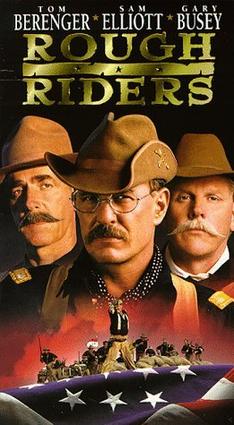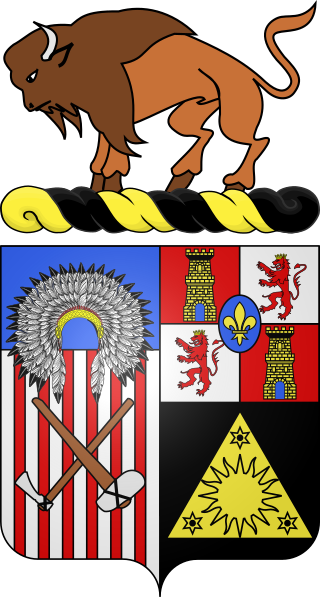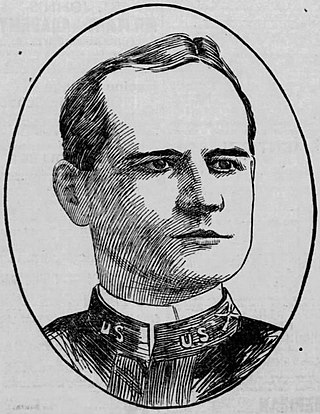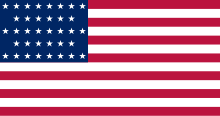
The Rough Riders was a nickname given to the 1st United States Volunteer Cavalry, one of three such regiments raised in 1898 for the Spanish–American War and the only one to see combat. The United States Army was small, understaffed, and disorganized in comparison to its status during the American Civil War roughly thirty years prior. Following the sinking of USS Maine, President William McKinley needed to muster a strong ground force swiftly, which he did by calling for 125,000 volunteers to assist in the war. The U.S. had gone to war in opposition to Spanish colonial policies in Cuba, which was then torn by a rebellion. The regiment was also nicknamed "Wood's Weary Walkers" for its first commander, Colonel Leonard Wood. This reflected their dissatisfaction that despite being cavalry, they ended up fighting in Cuba as infantry, since their horses were not sent there with them.

The Battle of San Juan Hill, also known as the Battle for the San Juan Heights, was a major battle of the Spanish–American War fought between an American force under the command of William Rufus Shafter and Joseph Wheeler against a Spanish force led by Arsenio Linares y Pombo. The combined assaults on Kettle Hill and San Juan Hill that together form San Juan Heights proved to be one of the most significant battles of the war and, along with the Siege of Santiago, a decisive battle in deciding the fate of the United States Army campaign in Cuba. The American forces, outnumbering the Spanish defenders 16-to-one, charged upon the heights and dispersed the Spanish after suffering heavy casualties.

The Battle of Las Guasimas of June 24, 1898 was a Spanish rearguard action by Major General Antero Rubín against advancing columns led by Major General "Fighting Joe" Wheeler and the first land engagement of the Spanish–American War. The battle unfolded from Wheeler's attempt to storm Spanish positions at Las Guasimas de Sevilla, in the jungles surrounding Santiago de Cuba, with the 1st U.S. Volunteer Cavalry and the 10th Regular Cavalry.

The Battle of El Caney was fought on July 1, 1898, during the Spanish-American War. 600 Spanish soldiers held for twelve hours, until they ran out of ammunition, against Henry W. Lawton's 5th US Division, made up of 6,899 men. This action temporarily delayed the American advance on the San Juan Hills, as had been requested of General William Rufus Shafter. Nevertheless, American forces advanced on San Juan Hill the same day. Though encountering spirited resistance similar to El Caney, the Americans were ultimately victorious, culminating in the capitulation of the Spanish garrison.

The Battle of Valverde, also known as the Battle of Valverde Ford, was fought from February 20 to 21, 1862, near the town of Val Verde at a ford of the Rio Grande in Union-held New Mexico Territory, in what is today the state of New Mexico. It is considered a major Confederate success in the New Mexico Campaign of the American Civil War, despite the invading force abandoning the field. The belligerents were Confederate cavalry from Texas and several companies of Arizona militia versus U.S. Army regulars and Union volunteers from northern New Mexico Territory and the Colorado Territory.

Rough Riders is a 1997 American television miniseries directed and co-written by John Milius about future President Theodore Roosevelt and the regiment known as the 1st US Volunteer Cavalry; a.k.a. the Rough Riders. The series prominently shows the bravery of the volunteers at the Battle of San Juan Hill, part of the Spanish–American War of 1898. It was released on DVD in 2006. The series originally aired on TNT with a four-hour running time, including commercials, over two consecutive nights during July 1997. It is, as of 2022, John Milius' last directorial credit for a film.

The 9th Cavalry Regiment is a parent cavalry regiment of the United States Army. Historically, it was one of the Army's four segregated African-American regiments and was part of what was known as the Buffalo Soldiers. The regiment saw combat during the Indian and Spanish–American Wars. During Westward Expansion, the regiment provided escort for the early western settlers and maintained peace on the American frontier.

The 10th Cavalry Regiment is a unit of the United States Army. Formed as a segregated African-American unit, the 10th Cavalry was one of the original "Buffalo Soldier" regiments in the post–Civil War Regular Army. It served in combat during the Indian Wars in the western United States, the Spanish–American War in Cuba, Philippine–American War and Mexican Revolution. The regiment was trained as a combat unit but later relegated to non-combat duty and served in that capacity in World War II until its deactivation in 1944.
Galvanized Yankees was a term from the American Civil War denoting former Confederate prisoners of war who swore allegiance to the United States and joined the Union Army. Approximately 5,600 former Confederate soldiers enlisted in the United States Volunteers, organized into six regiments of infantry between January 1864 and November 1866. Of those, more than 250 had begun their service as Union soldiers, were captured in battle, then enlisted in prison to join a regiment of the Confederate States Army. They surrendered to Union forces in December 1864 and were held by the United States as deserters, but were saved from prosecution by being enlisted in the 5th and 6th U.S. Volunteers. An additional 800 former Confederates served in volunteer regiments raised by the states, forming ten companies. Four of those companies saw combat in the Western Theater against the Confederate Army, two served on the western frontier, and one became an independent company of U.S. Volunteers, serving in Minnesota.
The 1st Nebraska Cavalry Regiment was a cavalry regiment that served in the Union Army during the American Civil War.

The 71st New York Infantry Regiment is an organization of the New York State Guard. Formerly, the 71st Infantry was a regiment of the New York State Militia and then the Army National Guard from 1850 to 1993. The regiment was not renumbered during the early 1920s Army reorganization due to being broken up to staff other units from 1917 to 1919, and never received a numerical designation corresponding to that of a National Guard regiment.

Thomas Harbo Rynning was an officer in the United States Army who served with Theodore Roosevelt's Rough Riders during the Spanish–American War. He was also the captain of the Arizona Rangers, warden of Yuma Territorial Prison, and a United States Marshal in San Diego, California.

The 1st Rhode Island Infantry Regiment were two regiments of the United States Army, the first of which was raised in 1861 at the beginning of the American Civil War on a 90-day enlistment, the second during the Spanish–American War in 1898.
The 7th Kentucky Infantry Regiment was an infantry regiment that served in the Union Army during the American Civil War.
The 1st Nevada Cavalry Battalion, or the Nevada Territory Cavalry Volunteers, was a unit raised for the Union army during the American Civil War. It remained in the west, garrisoning frontier posts, protecting emigrant routes, and engaged in scouting duties. The unit was disbanded in July 1866.

Jules Garesche "Gary" Ord was a United States Army First Lieutenant who was killed in action after leading the charge of Buffalo Soldiers of the 10th U.S. Cavalry up San Juan Hill. History now records that Ord was responsible for the "spontaneous" charge that took the San Juan Heights during the Spanish–American War in Cuba on July 1, 1898.

The 1st Regiment California Cavalry was a cavalry regiment in the Union Army during the American Civil War. First formed as a battalion, the unit later expanded to regimental size.
Hispanics in the American Civil War fought on both the Union and Confederate sides of the conflict. Not all the Hispanics who fought in the American Civil War were "Hispanic Americans" — in other words citizens of the United States. Many of them were Spanish subjects or nationals from countries in the Caribbean, Central and South America. Some were born in what later became a U.S. territory and therefore did not have the right to U.S. citizenship. It is estimated that approximately 3,500 Hispanics, mostly Mexican-Americans, Puerto Ricans and Cubans living in the United States joined the war: 2,500 for the Confederacy and 1,000 for the Union. This number increased to 10,000 by the end of the war.

John Henry Parker aka "Gatling Gun Parker" was a brigadier general in the United States Army. He is best known for his role as the commander of the Gatling Gun Detachment of the U.S. Army's Fifth Army Corps in Cuba during the Santiago campaign in the Spanish–American War.
The 2nd New Mexico Infantry Regiment, officially designated the 2nd Regiment New Mexico Volunteer Infantry or 2nd New Mexico Regiment Infantry, was a volunteer regiment in the Union Army, raised at Santa Fe, in the Territory of New Mexico, during July and August 1861. Its commander was Colonel Miguel E. Pino.














